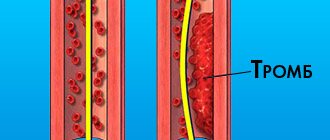A person cannot independently find out whether there is a blood clot. Read the article, it describes diagnostic methods and the first signs of thrombosis.
A thrombus is a collection of white blood cells, red blood cells and platelets that form a clot that blocks the flow of blood. Localized in the veins and arteries of various organs. If a blood clot blocks a vein or artery, it is a major health hazard and can even be fatal. In this article, we will look at how to find out if there is a blood clot in the body, how to diagnose it, and how to help a loved one if the blood clot has broken loose.
How to find out if a person has blood clots in the body in the vessels: symptoms, signs
Thrombus
A thrombus is a blood clot that completely or partially closes the lumen of a vessel, formed due to stagnation of blood in various organs. Thrombosis is a disease in which the presence of blood clots in the human body is confirmed by a doctor.
Important: This diagnosis should only be made by a doctor. If you notice the first signs or symptoms, you should immediately consult a doctor.
So how can you tell if a person has blood clots in their blood vessels? Some symptoms indicate this, but depending on the location of the blood clot in a particular organ, they vary significantly. Signs of blood clots in the body and their location:
- In the brain it can cause dizziness, headaches, and fainting.
- In the lower extremities - swelling, bluish skin, bruising.
- In the heart - pain in this organ, arrhythmias, ischemic heart disease, hypotension, shortness of breath, numbness of the hands.
- In other organs there will also be noticeable disruptions in their functioning.
The very presence of blood clots in the body is usually without symptoms, and the person feels unwell only in the organ where the blood clot is located. The worst thing is a complication, namely the detachment of a blood clot.
Remember: In such cases, there is a high probability of disability and death. The process occurs rapidly, in most cases minutes count - heart attack, stroke, pulmonary embolism, failure of other organs.
In such cases, a person needs urgent medical attention. The administration of necessary medications should be carried out as soon as possible and only by qualified personnel to avoid complications.
Contraindications to vascular MRI
A vascular MRI scan should not be performed if the patient has metal objects in the body, such as a pacemaker, insulin pump, or vascular clips. The electromagnetic field from an MRI machine can interfere with the normal functioning of these devices. And parts made of ferromagnets move and heat up under the influence of a magnet.
It is allowed to undergo MRI with titanium dentures, as well as dental implants and braces made of ceramics, plastic or polymers. Magnets do not work on these materials.
If the patient is afraid of closed spaces, the procedure can be performed in a state of medicated sleep.
How to determine whether there are blood clots in the legs, is a blood clot in the leg dangerous?
thrombus
is a blood clot that completely or partially blocks the flow of blood in the vessels. Thrombophlebitis or thrombosis is the presence of a blood clot in the vessels of the legs. Is a blood clot in the leg dangerous? It all depends on the complexity of the disease and the location of the blood clot. There are diseases associated with the formation of blood clots:
- Thrombophlebitis, thrombosis - causes inflammation and subsequent necrosis of nearby tissues, the temperature of the affected area is usually increased.
- Phlebothrombosis is when one or more blood clots are located in the veins of the lower extremities. With this disease, the temperature of the affected area is normal or the limbs may even be cool.
- Thrombosis can be arterial or venous . The difference lies in the mobility of the formed blood clots. So, in the first case, the probability of mobility of clots is high. In the second, it is practically reduced to zero, due to the lack of pressure and the presence of valves in the veins, which are an additional barrier to the mobility of blood clots.
A blood clot in the leg is dangerous because it poses a health threat. If a doctor diagnoses such a disease, the patient is first prescribed drug treatment, so that the blood clot should resolve on its own. If this does not happen, blood clots are “broken” using modern technologies: laser and other techniques.
How to determine if there are blood clots in the legs:
- A person may suspect this disease if he has swelling and cyanosis, usually of one leg.
- Only a doctor can diagnose the presence or absence of the disease using ultrasound.
- If the diagnosis is confirmed, treatment is prescribed.
Remember: All of the above diseases are dangerous, because if left untreated, they can lead to gangrene, and ultimately the loss of a limb.
In addition, with the blood flow, clots can move to other organs and cause their failure and lead to death.
Who to look for?
Venous thrombosis is a multifactorial disease that occurs under unfavorable circumstances. Today it is impossible to say for certain who is at risk of thrombosis and who is not (only in some cases a predisposition to thrombosis can be identified using a coagulogram - a comprehensive analysis of blood clotting indicators).
Article on the topic
Life without traffic jams. Russian scientists against thromboembolism Classic factors that provoke the appearance of blood clots include obesity, air travel, dehydration, long stays in a forced position, pregnancy, varicose veins (deep veins) and taking oral contraceptives.
This is only partly true. These circumstances can indeed lead to the formation of blood clots, but only with a complex effect. For example, if you sit motionless in an uncomfortable position for 9 hours on a plane and refuse drinks for the entire flight, while you suffer from obesity, varicose veins and take contraceptives, the chance of getting off the plane with a blood clot is really quite high. But if the matter is limited to one thing (for example, varicose veins or taking contraceptives), you risk no more than other people.
Surgeries and injuries (especially in combination) are considered truly dangerous factors. Such blood clots are considered clinically induced, so all herbal and post-operative patients are screened for the presence of blood clots.
In 10-20% of patients, thrombosis can serve as the first sign of malignancy. In patients over 50 years of age, when clinically unprovoked thrombosis is detected, an in-depth search for cancer is recommended.
Dissolve the clot. What foods improve blood quality Read more
Blood clot in the heart: what is it, symptoms, what to do?
Blood clot in the heart
If a blood clot is located in the vessels of the heart, then if it breaks off, it can lead to a heart attack, or its free movement to other organs and blockage of blood vessels. When a blood clot appears in the left atrium, the patient may experience the following symptoms:
- Fainting
- Numb hands
- Dyspnea
- Low blood pressure
- Heartache
- Pale skin
If a blood clot is found in the heart on the right:
- Cyanosis or blueness of the skin
- Dyspnea
- Weakness
- Hand tremors
- Nausea
The thrombus can move between the ventricles or be attached to a certain place by a kind of stalk. What to do at the first symptoms of a blood clot in the heart?
- Providing first aid consists of calling an ambulance.
- Providing assistance on your own is prohibited!
- The risk of an acute condition resulting in the death of the patient within a few minutes is very high.
- Therefore, the speed of providing qualified medical care is important.
Upon arrival, doctors immediately administer anticoagulants, for example:
- Heparin
- Enoxaparin
- Nadroparin
- Dalteparin
The patient should also receive treatment with fibrinolytics:
- Thromboflux
- Streptokinase and others
Important to know : If a person notices the first symptoms of such an ailment, it is necessary to urgently call doctors, otherwise the consequences may be irreversible.
How to check if there are blood clots in the heart?
Ultrasound of the heart
Stagnation of blood in the body leads to such a serious disease as thrombosis. It is difficult to identify immediately or independently, due to the lack of obvious symptoms. But how can you check if there are blood clots in the heart?
The patient should consult a doctor if he is concerned about:
- Chest pain
- Dyspnea
- Tachycardia
With a moving thrombus, the following are possible:
- Frequent fainting
- Pale skin
- Suffocation
- You may also feel dizzy often
- Break out in a cold sweat
To check whether there are blood clots in the heart, the cardiologist refers to the following types of diagnostic procedures:
- Ultrasound of the heart.
- Ultrasound of the abdominal cavity.
- Echocardiography.
- X-ray of the heart.
- Scintigraphy - shows what is happening inside the blood vessels and their position in the body.
- Dopplerography - measures heart pressure, speed, direction of blood flow in this organ.
- MRI helps to see the heart from the inside and determine the presence of a particular disease.
You should know: Call an ambulance immediately if a person experiences sharp, severe chest pain and blurred vision. Without timely medical care, a blood clot can break off and lead to a heart attack, stroke, or death.
How is vascular MRI performed in the POMC?
The procedure is carried out without special preparation.
Bring with you to the study an extract from your outpatient card, the results of past diagnostic examinations and other certificates related to the disease. If your doctor ordered an MRI, be sure to bring a referral.
Before starting the procedure, you must remove any metal objects: watch, phone, clothes with metal buttons.
Vascular MRI is performed in the supine position. The head and arms will be gently secured using special straps.
The operation of the device is associated with the rotation of a massive scanning ring around the body, which makes a lot of noise. To prevent it from disturbing you, you will be offered earplugs.
To ensure that the resulting images are clearly visible, you will need to lie still during the entire vascular MRI scan.
The MRI examination is painless, but if you feel more comfortable, a relative or loved one may be with you during the procedure.
Based on the results of the procedure, a medical opinion is issued. You receive photographs and a copy of the report. They should be taken to the doctor who referred you for a vascular MRI. If desired, the results of the study can be transmitted to you electronically.
Can a blood clot break off: is it dangerous, does a blood clot hurt?
Thrombus in the leg
As mentioned above, a thrombus is a clot of red blood cells, leukocytes and platelets that block the lumen of the vessel partially or completely. It depends on how it is attached:
- Parietal - attached to one side of the vessel wall.
- Central - located in the center and blood flows around it.
- Lining - encircles the vessel.
Does a blood clot hurt? Such a blood clot can be felt if it is in the superficial veins of the legs, in the form of a compaction. The surrounding tissues have a bluish tint. When you press on the damaged area, a sharp pain syndrome occurs.
Is a blood clot dangerous? Can it come off? It is dangerous when it is torn off, as it can block a vessel leading to a specific organ, causing negative consequences for the entire body as a whole.
This is why a detached blood clot is dangerous - pathologies, the consequences of which can be irreversible:
- Stroke occurs when a blood vessel in the brain is blocked.
- A heart attack is when a blood clot enters the heart.
- Pulmonary thromboembolism - when a blood clot migrates to the lungs.
- Swelling, inflammation of the tissues of the legs and the development of subsequent gangrene, threatening amputation.
- Failure of the liver, kidneys.
We have all been hearing about the danger of such a pathology for a long time. Doctors talk about this from TV screens. Therefore, when the first signs or unpleasant pain symptoms appear, you should immediately contact a doctor for examination and diagnosis.
Contraindications for MRI with contrast agent
The drugs used in our center are low-toxic and almost do not provoke allergies. The contrast agent is administered intravenously. Then it moves through the vascular system and is retained in the tissues. This method is used to increase the accuracy of research. Often, vascular MRI can be performed without the use of a contrast agent. There are 3 contraindications to this procedure:
- Contrast material may harm the fetus or pass into breast milk. Therefore, this procedure cannot be carried out during pregnancy or breastfeeding.
- It takes at least 24 hours to properly remove the contrast from the body. Therefore, chronic renal failure is also a contraindication to MRI with contrast agent.
- And the last contraindication: individual intolerance to the drug. It is possible to develop an allergic reaction to the components of the contrast agent.
A blood clot has broken off - how to find out: can you feel and see a blood clot, is it possible to save a person?
Thrombus
Only a doctor can see the presence of a blood clot using ultrasound diagnostics. It is almost impossible to feel it, but you can only feel the consequences of its presence in the body. Also, when you press on the skin in the area where the blood clot is located, you will feel pain.
If a blood clot breaks off, how can you tell, can you feel it or see it? If an attached blood clot has come off, you can tell by the person’s condition. Depending on the location of the vessel, painful symptoms may be as follows:
- In the brain , this will lead to a stroke. As a result, asymmetry of facial features, difficulty swallowing, and unclear speech.
- heart attack is possible in - pressing, sharp pain in the chest, or complete blockage of the heart vessels, which leads to death.
- In the intestines - a feeling of sharp pain in the abdomen and peritonitis.
- If a blood clot has blocked a vessel in the leg , swelling, blueness, redness, and severe pain are observed. In the absence of proper treatment - gangrene and amputation.
- Blockage in the lungs , also known as pulmonary embolism, is an acute condition that requires immediate hospitalization. It is characterized by a lack of oxygen, due to which the patient’s skin acquires a blue tint, shortness of breath is observed, and untimely assistance can lead to respiratory arrest and death.
Is it possible to save a person and how to provide first aid?
- An ambulance must be called immediately.
- In this case, painkillers and antispasmodics are important, but they should be taken only as directed by the emergency doctor.
- You also need to help the person find a comfortable position.
Often the correct actions of people around them help a person with an acute condition save a life.
Can a blood clot form after a leg injury, surgery, or blood draw?
Blood clot in the leg
Post-traumatic blood clot formation is not uncommon. Its serious consequences frighten and worry many people. When might he appear? Can a blood clot form after a leg injury, surgery, or blood draw?
- Any strong mechanical impact on the human body can cause damage to the vessel wall.
- Platelets rushing to help release thromboplastin and thrombin. These elements increase blood viscosity.
- In the injured area, a future thrombus is formed from fibrin fibers.
- This is a natural reaction of the body aimed at protecting against blood loss.
Surgical operations, blood drawing, and punctures in the body are directly related to the dissection and injury of blood vessels.
- With excessive platelet activity, the formation of an enlarged clot is inevitable.
- It may not have any negative impact in the future, or it may become a big problem.
- It all depends on the individual characteristics, health status, and lifestyle of the person.
Leg bruises are also not harmless.
- With a strong blow, a hematoma is formed - a bruise.
- This is a manifestation of rupture of small capillaries with slight hemorrhage.
- However, larger vessels located nearby may also be damaged.
To avoid severe outcomes and the development of thrombosis, you need to know the possible causes of blood clots and try to minimize them in your life.
Benefits of MRI
Magnetic resonance imaging is performed without the use of radioactive substances, and therefore does not have harmful radiation effects on the body. This procedure is harmless and can be repeated several times, for example, to monitor the progress of treatment.
MRI, unlike similar research methods, allows you to simultaneously see in the images all parts of the vascular system: both arteries and veins. This feature is necessary when it comes to injuries with large hematomas.
The design of a magnetic resonance imaging scanner allows you to obtain digital images of blood vessels in any projection and with any degree of approximation. After completing the examination, the specialist will have a three-dimensional model of your vascular system, which will allow you to make a more accurate diagnosis and prescribe the correct treatment.
Is it possible to detect and feel a blood clot on your own? Does a blood clot hurt in your leg?
Blood clot in the leg
Thrombosis is one of the serious diseases of the circulatory system. The reasons for the development of this pathology are injuries, surgical interventions, hormonal disorders, and increased blood viscosity. Is it possible to detect and feel a blood clot on your own? Does a blood clot in your leg hurt?
It will not be easy to independently detect a blood clot visually or by palpation. However, if you suspect the presence of blood clots, you should pay attention to the combination of symptoms. Signs of a blood clot in a vein are:
- Tissue swelling.
- Red or bluish areas on the skin near the vessel, their soreness.
- Increased body temperature.
- Pain that increases with movement of the affected limb.
- With long-term absence of treatment, the vascular network begins to stand out significantly.
With thrombophlebitis, superficial thrombosis, the pathological process develops closer to the skin. It will not be difficult for a knowledgeable person to feel a blood clot; upon palpation, the patient will feel pain and discomfort. But the pain syndrome may not appear if a small vessel is clogged and other veins and arteries take over its role.
Remember: There is no need to try to find a blood clot yourself, as this can be dangerous. The blood clot may be loosely attached to the wall of the vein or artery and may break off.
The best solution would be to consult a doctor who will conduct an examination, a series of studies and make an accurate conclusion about your health status.
Do people die from a blood clot: mortality statistics
Thrombus
The formation of a blood clot can occur in different parts of the body and it is very difficult to predict where exactly the blood clot is located. At a critical moment, it breaks away and begins to move, which is instantly fatal. People die from blood clots if treatment is not started in a timely manner and the person does not seek the help of doctors for a long time.
- Mortality statistics are such that more people die from thrombosis than from breast or prostate cancer.
- More than 10 million cases of thromboembolism occur worldwide each year.
Smoking, alcohol, and stress can develop this disease. If you want to be healthy, you should pay more attention to physical education, do morning exercises and worry less. It is also necessary to eat properly and drink clean water. This will guarantee your good health.
Is it possible to prevent a blood clot: prevention
Sport is the best prevention of thrombosis.
Every year in Russia alone, hundreds of thousands of people die from stroke. The most common type of stroke is ischemic, caused by a blockage of a blood vessel or a blood clot. It occurs 4 times more often than strokes due to vascular rupture. Is it possible to prevent a blood clot?
- Prevention of thrombosis involves thinning the blood. We need to accelerate it so that there is no stagnation.
- Any physical exercise will help you do this . You should exercise at least 30 minutes a day. It is important to walk a lot in the fresh air.
- People who are inactive most often suffer from stroke , so prevention in the form of daily physical activity is mandatory.
As mentioned above, in order to avoid the appearance of blood clots, you need to follow a drinking regime. You should drink at least two liters of water daily. To be completely sure, you can take medications that improve blood circulation. But this should be done only after consulting a doctor.
Remember : Self-medication is dangerous!
If you have blood clots in your legs, can you walk in heels, smoke and drink alcohol?
If you have thrombosis, it is forbidden to wear heels.
We are always told about the dangers of alcohol and smoking on the body. We can say with confidence that these habits provoke the development of thrombosis. For healthy people, as well as for patients with blood clots in the legs, it is harmful to smoke, drink alcohol and for women to walk in heels. Read more below.
Smoking:
- Doctors who often encounter a similar disease have concluded that tobacco plays a big role in the development of thrombosis.
- A person who smokes puts himself at great risk, as the blood thickens and a blood clot can form in the vessels.
- Accordingly, smoking is also harmful in the presence of thrombosis.
Drinking alcohol is also very dangerous for health:
- When a person is in a normal state, his blood moves through the veins at the correct speed.
- As soon as you drink a little strong alcohol, it begins to thicken and move through the veins at high speed.
- People believe that alcohol thins the blood, but this is not true. The speed of blood flow simply increases.
- At this moment, if there are blood clots in the body, they can break away from their base and death will occur instantly.
Women love to dress well and wear high heels:
- If a woman has varicose veins, then such shoes are strictly prohibited.
- The legs will be constantly under tension and this will cause stagnation of blood in the veins, which will have a detrimental effect on health.
- Also, such shoes can provoke the formation of a blood clot.
- If you already have blood clots in your legs, wearing heels is prohibited!
Sitting for long periods of time also has a negative impact on health. Therefore, for example, office workers and people who like to sit at the computer for a long time need to take breaks every hour for 10-15 minutes.
Advice: Try to move more, smoke less and do not drink alcohol, wear the right orthopedic shoes. This will help protect yourself from unwanted consequences.
When do you need to take the THROMBOPHILIA extended test?
- Cases of hereditary thromboembolism in the family.
- History of thrombosis:
- single thrombosis before 50 years of age;
- repeated thromboses;
- a case of thrombosis at any age with a family history;
- thrombosis of unusual localization (portal, mesenteric, cerebral veins);
- thrombosis of unknown etiology after 50 years.
- High risk situations:
- massive surgical interventions;
- long-term immobilization;
- oncological diseases;
- chemotherapy.
- Ischemic stroke.
- Cardiovascular diseases.
- Prescription of standard antiplatelet therapy.
- Use of hormonal contraception or hormone replacement therapy.
- Planning pregnancy in women with a history of thrombosis, 1st degree relatives with diagnosed hereditary thrombophilia, or a family history of thromboembolic complications.
- Complicated obstetric history.
Could there be a blood clot in the arm?
Blood clot in the arm
According to research and the experience of doctors, blood clots can form in various organs and in any part of the human body, including in the arm. When this happens, a person experiences the following symptoms:
- The affected hand is colder than the other. Due to impaired blood formation, the affected hand becomes colder than the other. But such a symptom is difficult to notice on your own.
- Decreased sensitivity. First, bodily sensations become weak, and then pain sensitivity decreases. A person may not even notice when he is burned by hot objects.
- Swelling of the hand. When there is a blood clot in a vein in the arm, it causes swelling. This symptom is almost impossible to ignore, as it brings severe discomfort.
- Increased body temperature. This happens if a blood clot appears in a vein. Body temperature rises slightly. Usually it is kept at 37.5 - 38.0 degrees.
The first signs of a blood clot:
- The person feels quickly exhausted and tired
- Breathing is difficult
- Dizziness and fainting may occur
- Palpitations, headache
The main danger of thrombosis is that often this disease is not traced and is not felt in any way by the human body. Only some external changes may appear in the affected area, but people often do not attach any importance to this. Therefore, it is important to prevent thrombosis: daily physical activity, do not sit in one place for a long time, monitor your weight and nutrition, drink plenty of water. Good luck!









